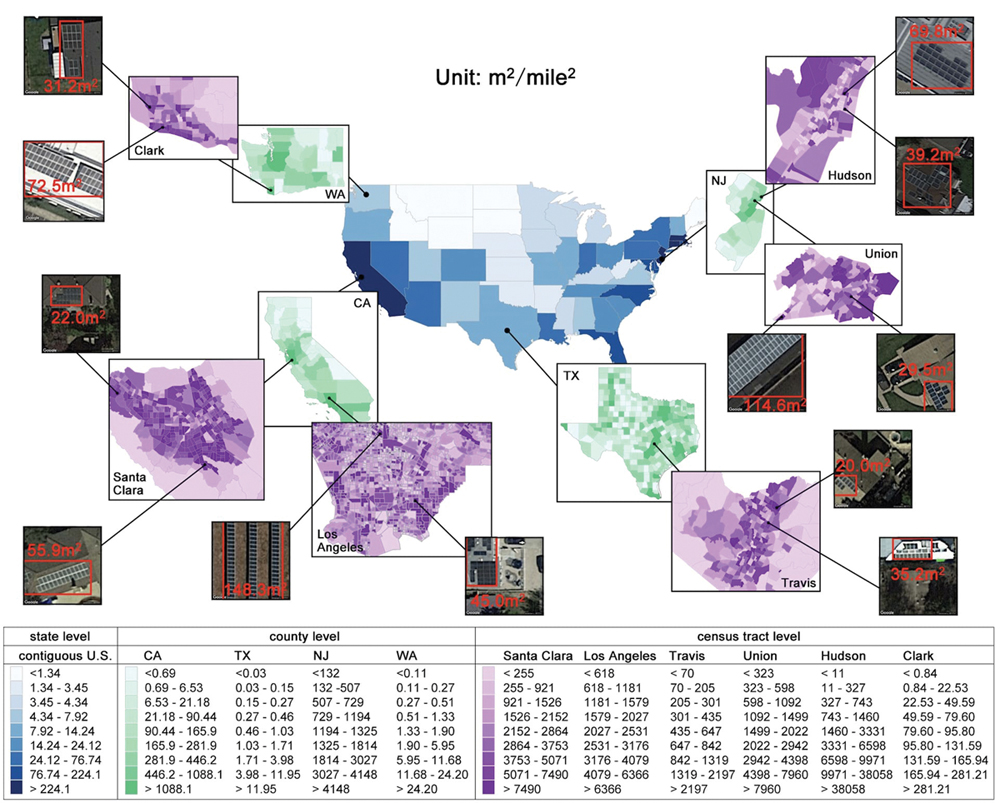Stanford University scientists analyzed more than a billion high-resolution satellite images with a machine learning algorithm and identified nearly every solar power installation in the contiguous 48 states.
 The analysis found 1.47 million installations, a much higher figure than either of the two estimates widely recognized previously. The scientists also integrated U.S. Census and other data with their solar catalog to identify factors leading to solar power adoption.
The analysis found 1.47 million installations, a much higher figure than either of the two estimates widely recognized previously. The scientists also integrated U.S. Census and other data with their solar catalog to identify factors leading to solar power adoption.
The team trained the machine learning program, DeepSolar, to identify solar panels by providing it about 370,000 images, each covering about 100 feet by 100 feet. Each image was labelled as either having or not having a solar panel present. From that, DeepSolar learned to identify features associated with solar panels — for example, color, texture and size.
“We don’t actually tell the machine which visual feature is important,” said Jiafan Yu, a doctoral candidate in electrical engineering who built the system with Zhecheng Wang, a doctoral candidate in civil and environmental engineering. “All of these need to be learned by the machine.”
Eventually, DeepSolar could correctly identify an image as containing solar panels 93 percent of the time and missed about 10 percent of images that did have solar installations. On both scores, DeepSolar is more accurate than previous models, the authors say in the report.
The group then had DeepSolar analyze the billion satellite images to find solar installations — work that would have taken existing technology years to complete. With some novel efficiencies, DeepSolar got the job done in a month.
The resulting database contains not only residential solar installations, but those on the roofs of businesses, as well as many large, utility-owned solar power plants. The scientists, however, had DeepSolar skip the most sparsely populated areas, because it is very likely that buildings in these rural areas either do not have solar panels, or they do but are not attached to the grid. The scientists estimated based on their data that 5 percent of residential and commercial solar installations exist in the areas not covered.
“Advances in machine learning technology have been amazing,” Wang said. “But off-the-shelf systems often need to be adapted to the specific project and that requires expertise in the project’s topic. Jiafan and I both focus on using the technology to enable renewable energy.”
Moving forward, the researchers plan to expand the DeepSolar database to include solar installations in rural areas and in other countries with high-resolution satellite images. They also intend to add features to calculate a solar installation’s angle and orientation, which could accurately estimate its power generation. DeepSolar’s measure of size is for now only a proxy for potential output.
The group expects to update the U.S. database annually with new satellite images. The information could ultimately feed into efforts to optimize regional U.S. electricity systems, including Rajagopal and Yu’s project to help utilities visualize and analyze distributed energy resources.
The results are described in a paper published in the Dec. 19 issue of Joule. The data are publicly available on the project’s website, http://web.stanford.edu/group/deepsolar/home.
